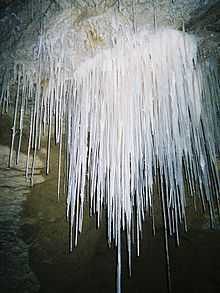Soda straw


A soda straw (or simply straw) is a speleothem in the form of a hollow mineral cylindrical tube. They are also known as tubular stalactites. Soda straws grow in places where water leaches slowly through cracks in rock, such as on the roofs of caves. A soda straw can turn into a stalactite if the hole at the bottom is blocked, or if the water begins flowing on the outside surface of the hollow tube.
These tubes form when calcium carbonate or calcium sulfate dissolved in the water comes out of solution and is deposited. In soda straws, as each drop hovers at the tip, it deposits a ring of mineral at its edge. It then falls and a new drop takes its place. Each successive drop of water deposits a little more mineral before falling, and eventually a tube is built up. Stalagmites or flowstone may form where the water drops hit the cave floor.
Soda straws are some of the most fragile of speleothems. Like helictites, they can be easily crushed or broken by the slightest touch. Because of this, soda straws are rarely seen within arms' reach in show caves or others with unrestricted access. When left alone, soda straws have been known to grow up to 9 metres (30 feet) long . Kartchner Caverns in southern Arizona has well-preserved soda straws because of its recent discovery in 1999 and highly regulated traffic.[1]
References
- ↑ Rivenburg, Roy (November 14, 1999). "Arizona's Deep, Dark Secret". Los Angeles Times.
External links
- Showcaves.com definition and explanation
- The Virtual Cave soda straw photos
- A photo of some amazing soda straws in south eastern France
| ||||||||||||||||||||||||||||||||||||||||||||